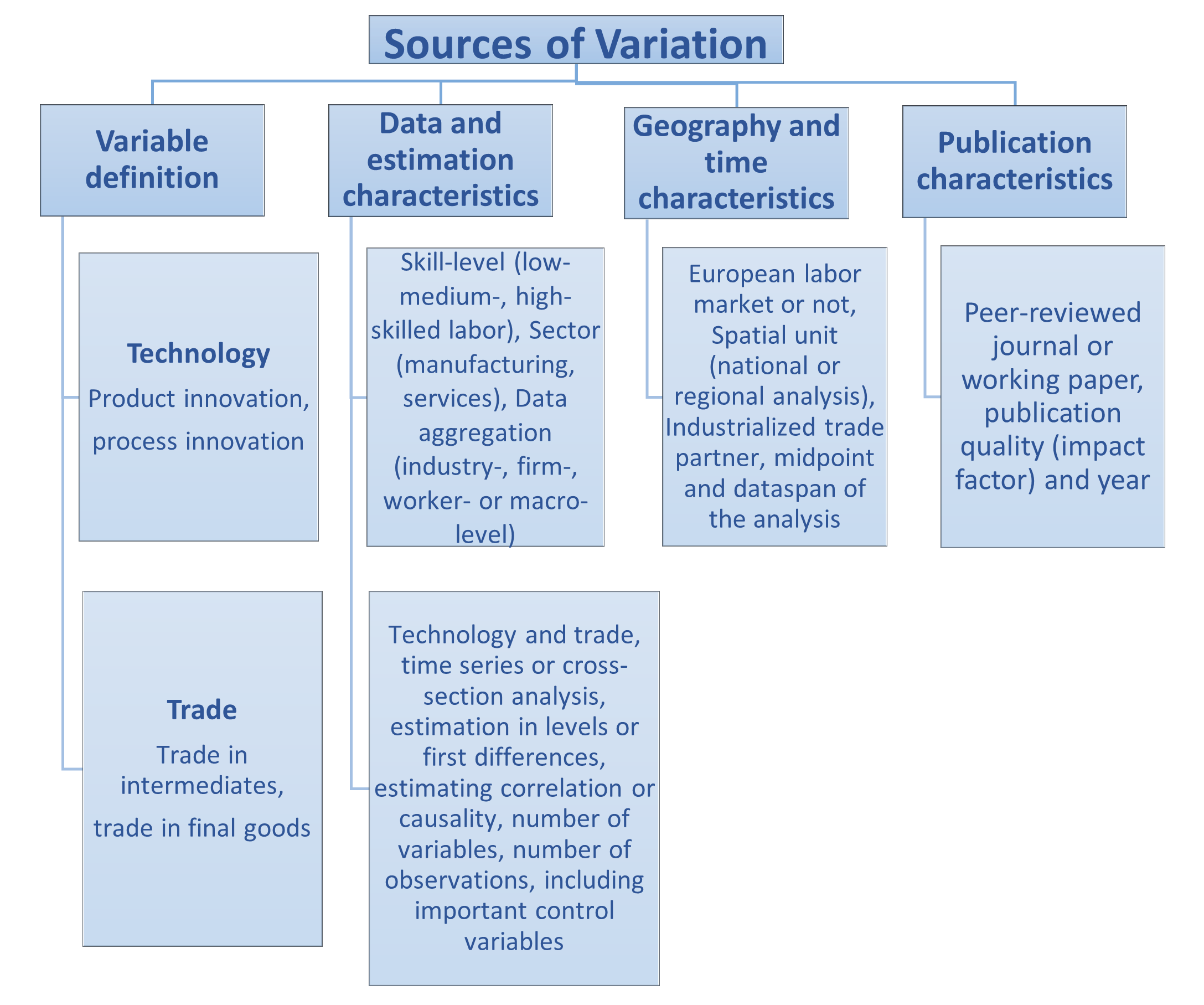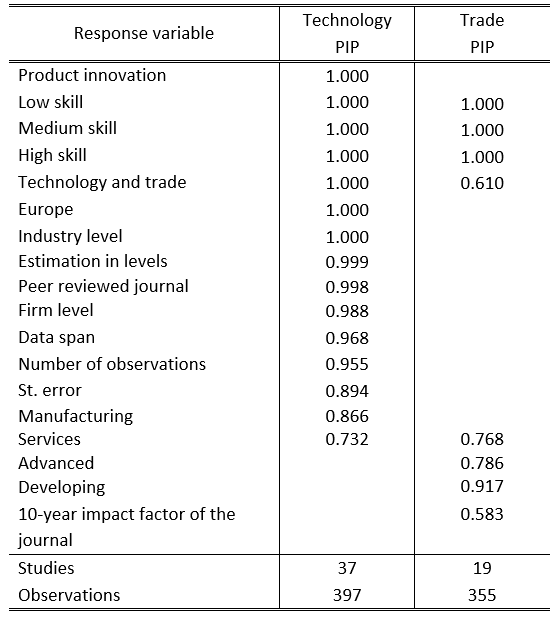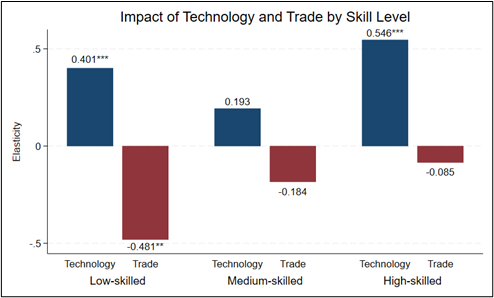

Abstract
Research reports mixed results on the impact of trade and technological progress on employment in advanced economies. Using Bayesian Model Averaging, we conduct a meta-regression analysis of 397 technology and 355 trade employment elasticities from 56 studies in order to draw conclusions from this research base. Controlling for publication bias (mainly in reported technology elasticities) and study design characteristics, our best practice estimates show that technology increases employment of low-skilled and high-skilled workers, while trade reduces employment of low-skilled workers.
In a recent study (Terzidis et al., 2025), we address a long-standing empirical and policy debate: to what extent have globalization (trade) and technological change influenced employment patterns in advanced economies? With the reemergence of protectionist rhetoric, particularly in the context of the Trump presidency, attention has turned towards (the perceived) job losses linked to trade and technology. With respect to trade especially import competition with China stands out. But in general, the discussion focusses on the negative aspects of trade and technology. The empirical evidence on the employment effects of technology and trade is rather mixed. It is well known that methodological, specification, and data differences affect empirical estimates. These differences can lead to heterogeneity in reported estimates. A meta-regression analysis can help to draw inferences from an existing body of literature, even if results are mixed. Meta-regression analysis helps to explain why results differ systematically within and between studies. It is based on a focused examination of the role of methodological, specification, and data factors on, in our case, the reported technology and trade employment elasticities. It thus can help to answer the question of how trade and technology affect employment: who gains, who loses.
In general, our study highlights the skill level of the workforce as the main factor conditioning the impact from technology and trade. In essence, we find that technology increases employment of low-skilled and high-skilled workers, while trade reduces employment of low-skilled workers.
According to the Heckscher-Ohlin-Stolper-Samuelson (HOSS) models, countries export goods that intensively use their abundant production factors, with price changes influencing factor utilization. This suggests a decline in high-skilled employment in advanced economies, yet the 1980s saw the opposite—rising high-skilled employment despite higher relative wages—indicating the role of skill-biased technological change. For HOSS effects to be significant, trade flows must be large, but studies found that during the 1980s–1990s U.S. import volumes were too small to explain labor market shifts (Borjas et al., 1997; Berman et al., 1998; Krugman, 2000). As a result, technology was considered the main driver of employment changes. Technological progress increases demand for high-skilled workers and may make low-skilled jobs obsolete (Helpman, 2009). It can also substitute labor through process innovations and affect sectors unevenly. However, trade and technology effects are hard to separate because both can explain labor outcomes. Grossman and Rossi-Hansberg (2008), for example, conclude on mixed effects from offshoring: reducing costs, boosting productivity, and acting as a low-skill biased technical change, but also increasing labor supply pressures. Overall, technological progress can complement or counteract trade’s effects, contributing to mixed evidence on their relative roles in shaping employment.
The mixed evidence of recent literature can be illustrated by patenting, which was linked to employment growth in the U.S. (Balasubramanian and Sivadasan, 2011), but this effect was limited to high-tech manufacturing in Europe (Van Roy et al., 2018). Similarly, the impact of industrial robots remains inconclusive: Acemoglu and Restrepo (2020) report job losses in the U.S., while Dauth et al. (2021) show German service job gains offset manufacturing losses. Graetz and Michaels (2018) found no significant effects in six advanced economies.
Evidence on skill-level effects also varies. While technology generally raises demand for high-skilled labor (Wright, 2014; Crinò, 2012), results differ by country and method. Some studies (Dixon, 2020; Koch et al., 2021) suggest low-skilled workers benefit, but others (Acemoglu et al., 2020; Crinò, 2012) show job losses.
Trade’s impact is similarly debated. Early research (Amiti and Wei, 2005; Michel and Rycx, 2012) found minimal labor effects, while later studies, such as Acemoglu et al. (2016) and Autor et al. (2021), attribute substantial U.S. job losses to Chinese imports. Yet other studies stress skill-level variation: Wright (2014) finds negative effects for low-skilled workers but small gains for high-skilled ones, and Crinò (2012) finds services offshoring complements high-skilled labor, while goods offshoring substitutes low-skilled labor.
Few studies consider trade and technology together. Autor et al. (2015) find trade reduces overall employment, while technology mainly alters job composition. Overall, research findings depend heavily on study design, sector, workforce skill levels, and measurement methods, highlighting the value of a meta-analysis to distil robust insights.
To better understand how technology and trade affect jobs in advanced economies, we review and analyze findings from many existing studies. We follow a well-established four-step process to ensure a thorough and unbiased literature search. This process includes looking through peer reviewed academic papers, working paper series, and existing review articles. After reviewing over 1,300 studies, we narrowed our sample down to 56 high-quality studies that clearly measured how technology or trade impact employment. From each of these studies, we collect as many labor market impact estimates (employment elasticities) as possible. Employment elasticities measure the responsiveness of employment to changes in technology or trade. This resulted in nearly 400 estimates for technology and over 350 for trade. These numbers allow us to spot trends and differences across studies, such as the impact of trade or technology on low-, medium-, and high-skilled workers.
Figure 1 shows the distribution of the technology elasticities (panel on the left) and the trade elasticities (panel on the right) as reported in the studies considered by skill level. The figure suggests that, on average, technology benefits both low- and high-skilled workers at the expense of medium-skilled workers, while trade positively affects high-skilled workers at the expense of both low- and medium-skilled workers.
Figure 1. Distributions of estimated technology and trade elasticities by skill level

Notes: Vertical lines inside the boxed indicate the median values by skill level (technology sample: 0.049 for low-skill, -0.072 for medium skill and 0.016 for high skill and trade sample: -0.010 for low-skill, -0.018 for medium skill and 0.133 for high skill). The median is the value for which 50% of the data lies on its left-hand side and 50% lies on the right-hand side. The left edge of the box represents the lower quartile, while the right edge of the box shows the upper quartile. The values at the extremes of the horizontal lines are the lowest and highest reported elasticities.
However, Figure 1 is just summarizing the results of all studies considered, without accounting for differences across these studies. A proper meta-analysis is needed to resolve conflicting empirical findings (Doucouliagos et al., 2022). A meta-analysis identifies the most relevant factors that could explain differences between various studies and draws robust inferences from the evidence base. Think of issues such as the country under consideration, the time period considered, skill levels, the type of technological progress, the econometrics used, but also whether and where the study has been published. Figure 2 shows all these factors considered.
Figure 2. Study characteristics considered in the meta-regression analysis

Bayesian Model Averaging (BMA) approach implies that we estimate all possible combinations of variables considered and identify the “best” models based on the the posterior inclusion probability (PIP), measuring the importance of each variable. To interpret the PIP, we follow the thresholds used in the literature, suggesting that PIPs below 0.5 suggest no significance. Table 1 reports the PIPs of the variables that have a PIP above 0.50.
Our analysis shows that the impact of technology on employment differs across skill levels. According to the BMA results, the reported elasticities are 0.025 higher for low-skilled workers and 0.049 higher for high-skilled workers than those for medium-skilled workers. Our results also suggest that the employment elasticities of product innovation are 0.01 higher than those of process innovation. The BMA analysis also illustrates the importance of the model specification. First, when the model estimated includes a trade variable, the reported technology elasticity is 0.044 larger, suggesting important complementarities between the technology and the trade effects. Similarly, estimating the model in levels leads to higher reported elasticities by 0.012 compared to first-differenced models.
The impact of trade on employment also differs between different skill levels. The BMA results show that the reported elasticities are 0.095 lower for low-skilled workers, while the reported elasticities are 0.062 higher for high-skilled workers. Finally, our results show that the trade elasticities reported in models that include technology are larger by 0.018.
Table 1. Explaining the variation in the technology and trade meta-samples

We can use the BMA estimates to come up with a synthetic estimate, often called ‘best practice’. We proceed in two steps. In the first step, we select variables to include in the best practice estimates. The BMA outcomes of Table 1 provide the most relevant variables from which we can choose. The criteria for our most preferred methodology are as follows: First, our preferred methodology relates to models using first differences. Second, the model should include both technology and trade variables as well as important controls. Third, the preferred estimation strategy is to use time series with a time lag between the explanatory and the dependent variable and to use an instrumental variable approach to account for the endogeneity of technology and trade. We also assume that the trade takes place between a European and a developing economy. Finally, the primary study should have recently been published in a high quality peer-reviewed journal.
In the second step, for each of the variables that we include in the synthetic estimate we multiply the estimated marginal effect of the variable with the maximum value of this variable in the technology or trade sample. For example, the maximum value of the 10-year impact factor of a journal in which a trade study has been published is 23.76 and this is multiplied with the estimated marginal effect according to the BMA, which amounts to -0.017. For explanatory variables that are dummy variables, the maximum value obviously is 1, which we multiply by the marginal effect.
Figure 3 shows the outcomes of the ‘best practice’ estimates. Based on this figure, we draw the following conclusions. First, technology is employment-friendly, particularly when the full spectrum of study design characteristics is taken into account. Contrary to fears of mass job destruction, technology has contributed positively to labor demand in many settings—especially for high-skilled and, perhaps more surprisingly, low-skilled workers. Second, trade has more nuanced effects. Trade tends to displace low-skilled workers, especially in advanced economies engaging in vertical specialization with low-wage countries.
Figure 3. Best practice estimated technology and trade elasticities

Acemoglu, D., Autor, D., Dorn, D., Hanson, G. H., & Price, B. (2016). Import competition and the great US employment sag of the 2000s. Journal of Labor Economics, 34(1, pt. 2), S141–S198. https://doi.org/10.1086/682384
Acemoglu, D., Lelarge, C., & Restrepo, P. (2020). Competing with robots: Firm-level evidence from France. AEA Papers and Proceedings, 110, 383–388. https://doi.org/10.1257/pandp.20201003
Acemoglu, D., & Restrepo, P. (2020). Robots and jobs: Evidence from US labor markets. Journal of Political Economy, 128(6), 2188–2244. https://doi.org/10.1086/705716
Amiti, M., & Wei, S.-J. (2005). Fear of service outsourcing: Is it justified? Economic Policy, 20(42), 308–347. https://doi.org/10.1111/j.1468-0327.2005.00140.x
Autor, D. H., Dorn, D., & Hanson, G. H. (2015). Untangling trade and technology: Evidence from local labour markets. Economic Journal, 125(584), 621–646. https://doi.org/10.1111/ecoj.12245
Autor, David & Dorn, David & Hanson, Gordon. (2021). On the Persistence of the China Shock. SSRN Electronic Journal. https://doi.org/10.2139/ssrn.3973950.
Balasubramanian, N., & Sivadasan, J. (2011). What happens when firms patent? New evidence from U.S. economic census data. The Review of Economics and Statistics, 93(1), 126–146. Available at: https://www.jstor.org/stable/23015924
Berman, E., Bound, J., & Machin, S. (1998). Implications of skill-biased technological change: International evidence. The Quarterly Journal of Economics, 113(4), 1245–1279. https://doi.org/10.1162/003355398555892
Borjas, G. J., Freeman, R. B., & Katz, L. F. (1997). How much do immigration and trade affect labor market outcomes? Brookings Papers on Economic Activity, 1997(1), 1–67. Available at: https://pubmed.ncbi.nlm.nih.gov/12321914/
Crinò, R. (2012). Service offshoring and the skill composition of labour demand. Oxford Bulletin of Economics and Statistics, 74(1), 20–57. https://doi.org/10.1111/j.1468-0084.2010.00634.x
Dauth, W., Findeisen, S., Suedekum, J., & Woessner, N. (2021). The adjustment of labor markets to robots. Journal of the European Economic Association, 19(6), 3104–3153. https://doi.org/10.1093/jeea/jvab012
Dixon, J. (2020). The effect of robots on firm performance and employment. Economic Insights – Statistics Canada, 126. Available at: The Effect of Robots on Firm Performance and Employment
Doucouliagos, H., de Haan, J., & Sturm, J.-E. (2022). What drives financial development? A meta-regression analysis. Oxford Economic Papers, 74(3), 840–868. https://doi.org/10.1093/oep/gpab044
Graetz, G., & Michaels, G. (2018). Robots at work. The Review of Economics and Statistics, 100(5), 753–768. https://doi.org/10.1162/rest_a_00754
Grossman, G. M., & Rossi-Hansberg, E. (2008). Trading tasks: A simple theory of offshoring. American Economic Review, 98(5), 1978–1997. https://doi.org/10.1257/aer.98.5.1978
Havranek, T., Irsova, Z., Laslopova, L., & Zeynalova, O. (2024). Publication and attenuation bias in measuring skill substitution. The Review of Economics and Statistics, 106(5), 1187–1200. https://doi.org/10.1162/rest_a_01227
Helpman, E. (2009). The mystery of economic growth. Harvard University Press.
Koch, M., Manuylov, I., & Smolka, M. (2021). Robots and firms. The Economic Journal, 131(638), 2553–2584. https://doi.org/10.1093/ej/ueab009
Krugman, P. R. (2000). Technology, trade and factor prices. Journal of International Economics, 50(1), 51–71. https://doi.org/10.1016/S0022-1996(99)00016-1
Michel, B., & Rycx, F. (2012). Does offshoring of materials and business services affect employment? Evidence from a small open economy. Applied Economics, 44(2), 229–251. v https://doi.org/10.1080/00036846.2010.503932
Terzidis, N., Brakman, S., de Haan, J., & Ortega-Argilés, R. (2025). Unpacking the nexus: How trade and technology shape employment dynamics—a meta-regression analysis. SSRN. http://dx.doi.org/10.2139/ssrn.5235809
Van Roy, V., Vértesy, D., & Vivarelli, M. (2018). Technology and employment: Mass unemployment or job creation? Empirical evidence from European patenting firms. Research Policy, 47(9), 1762–1776. https://doi.org/10.1016/j.respol.2018.06.008
Wright, G. C. (2014). Revisiting the employment impact of offshoring. European Economic Review, 66, 63–83. https://doi.org/10.1016/j.euroecorev.2013.11.008